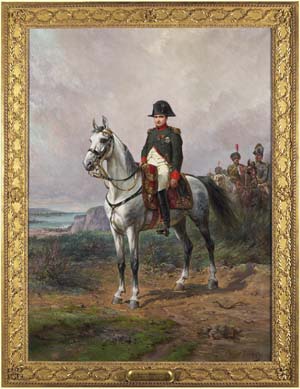The directory «Plots of stamps in the catalogue»
War with Fourth Coalition
1806—1807

As a watcher from the sidelines, Prussia became increasingly more concerned at French influence spreading over the minor German states and, in October 1806, finally joined Britain and Russia against Napoleon Bonaparte. On 8 October, Bonaparte launched a surprise invasion of Prussia and within days had the unprepared, sabre-rattling monarchy of Frederick-William III under extreme pressure. Berlin was in danger of being captured and the king's nephew, Prince Louis Ferdinand, had been killed during the defeat at Saalfield. On 14 October, two battles occurred with the French main army, under Bonaparte, crushing Prince Frederick Hohenloe at Jena and Marshal Davout overcoming astounding odds to defeat the bulk of Prussia's army at Auerstadt. Ten days later the capital of Berlin was captured and within a month the final Prussian army surrendered at Lubeck, forcing Frederick William III to run for sanctuary in Russia. Bonaparte immediately moved against the Russians, captured Warsaw and would have caught up with the Russian army but for a brutal clash at Pultusk that allowed General Levin Bennigsen to escape. The harsh winter of early 1807 had both sides in camp but Bennigsen moved within Bonaparte's reach and the emperor set out to destroy him. The result was the battle of Eylau, which was one of the bloodiest of the Napoleonic Wars and one fought in possibly the worst conditions. A blinding snowstorm turned the battle into a mistake-riddled bloodbath and while indecisive, still cost 25,000 French casualties and 15,000 Russian ones. The crucial battle of the campaign came at Friedland where Bennigsen moved against a single French corps only to be pinned by the skilful defence of Marshal Jean Lannes. With reinforcements quickly arriving, the French trapped the Russians against the River Alle and proceeded to destroy it. Bonaparte's army suffered some 10,000 killed and wounded, but the Russian dead and injured were up to 25,000. Shattered by the speed of his defeat, Tsar Alexander met the French emperor on a raft in the middle of the River Niemen and signed the Treaty of Tilsit. That document slightly embarrassed the Tsar by forcing him into an alliance with France against Britain, but it humiliated Prussia by allowing French occupation of that country until a 140-million franc indemnity was paid, broke Polish territories from Berlin in the form of the new Duchy of Warsaw and gave the infant Confederation of the Rhine considerably greater lands. Napoleon Bonaparte was now, probably, at the zenith of his career.
Ajman, 1972, Napoleon and Queen Luisse of Prussia in Tilsit
France, 2004, Napoleon
Fujeira, 1970, Napoleon meet Queen of Prussia
Manama, 1972, Napoleon and Queen Luisse of Prussia in Tilsit
Manama, 1972, Napoleon and Queen Luisse of Prussia in Tilsit
Ras al-Khaima, 1970, Napoleon in Tilsit
Ras al-Khaima, 1970, Napoleon and Queen Luisse of Prussia in Tilsit
Rwanda, 1969, Decorating Soldier befor Tilsit